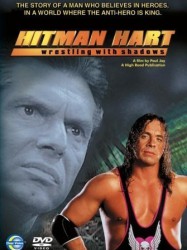Les films ayant le thème "Documentaire sur le catch", triés par recette

Au-delà du ring (1999)
, 1h42Réalisé par Barry W. Blaustein
Origine Etats-Unis
Genres Documentaire
Thèmes Sport, Documentaire sur le sport, Documentaire sur le catch
Acteurs Mick Foley, Jesse Ventura, Dwayne Johnson, Stone Cold Steve Austin, Barry W. Blaustein, Paul Heyman
Le film commence avec le réalisateur Barry Blaustein exposant son amour du catch professionnel et des extraits d'interviews d'employés de la World Wrestling Federation et de l'Extreme Championship Wrestling. Il décide alors de voyager dans tous les États-Unis pendant trois ans, essayant de comprendre à quoi pense une personne qui choisit volontairement de devenir catcheur professionnel. Blaustein interview un grand nombre de personnalités du catch et réussit à englober leurs motivations.

I'm from Hollywood (1989)
, 1h1Genres Comédie, Documentaire
Thèmes Sport, Documentaire sur le sport, Documentaire sur le catch, Documentaire sur une personnalité
Acteurs Andy Kaufman, Tony Danza, Marilu Henner, Robin Williams, Bob Zmuda
 , 1h33
, 1h33Réalisé par Paul Jay
Genres Documentaire
Thèmes Sport, Documentaire sur le sport, Documentaire sur le catch, Documentaire sur une personnalité
Acteurs Stone Cold Steve Austin, Mick Foley, Marc Mero, Randy Savage, Triple H, Shane McMahon
Bret « The Hitman » Hart est un catcheur professionnel employé à la WWF.
 , 1h15
, 1h15Origine Etats-Unis
Genres Documentaire
Thèmes Sport, Documentaire sur le sport, Documentaire sur le catch, Documentaire sur une personnalité
Acteurs Cyndi Lauper, Bill Cosby, Betty White
The documentary tells its story by focusing on the careers of six women—The Fabulous Moolah, Mae Young, Gladys "Kill 'Em" Gillem, Ida Mae Martinez, Ella Waldek and Penny Banner. It begins by describing the beginning of wrestling in the 1930s. By the 1940s, American men had to leave the country to fight in World War II, leaving females to take over the sport. At first, women's wrestling was seen as a side-show, and it was banned in several states. The film mostly focuses on these years—the 1940s—along with the 1950s and 1960s, better known as the "heyday of women's wrestling", when the sport became more accepted and popular.
[...]Voir plus...

WWE: The Rise & Fall of ECW (2004)
Réalisé par Kevin Dunn
Genres Documentaire
Thèmes Sport, Documentaire sur le sport, Documentaire sur le catch
Acteurs Stone Cold Steve Austin, Paul Heyman
 , 1h24
, 1h24Origine Etats-Unis
Genres Documentaire
Thèmes L'enfance, Sport, Documentaire sur le sport, Documentaire sur le catch, Documentaire sur une personnalité
The documentary (84 min) covers the birth and development of a professional style wrestling league from the mid-1980s that was produced by young teens aging from 12 to 16 years of age. The film covers the rise and fall of a unique wrestling experience for both the fans and kids that were involved. The film includes footage from the original NWF productions as well as current interviews with past NWF participants.

Que viva la lucha (2007)
, 54minutesGenres Documentaire
Thèmes Sport, Documentaire sur le sport, Documentaire sur le catch
The film opens at the Auditorio de Tijuana to scenes of wrestlers and cheering fans. Following these scenes, the film proceeds to break down the concept of lucha libre and its cultural significance by following the dual lives of professional luchadores: Extreme Tiger, Angel Negro Jr., and Pancho Cachondo, all working-class individuals from Tijuana who become local heroes in the community the moment they put on their masks. The film breaks down Tijuana’s lucha libre components respectively:

Vampiro: Angel, Devil, Hero (2008)
, 1h30Réalisé par Lee Demarbre
Origine Canada
Genres Documentaire
Thèmes Sport, Documentaire sur le sport, Documentaire sur le catch, Documentaire sur une personnalité

Bloodstained Memoirs (2009)
Origine Etats-Unis
Genres Documentaire, Historique
Thèmes La mer, Sport, Transport, Documentaire sur le sport, Documentaire sur le catch
Acteurs Chris Jericho, Mick Foley

Catch: The Hold Not Taken (2005)
, 1hGenres Documentaire
Thèmes Sport, Documentaire sur le sport, Documentaire sur le catch

La lutte (1961)
Réalisé par Claude Jutra, Michel Brault, Claude Fournier, Marcel Carrière
Genres Documentaire
Thèmes Sport, Documentaire sur le sport, Documentaire sur le catch, Documentaire sur les villes

The Backyard (2002)
, 1h20Origine Etats-Unis
Genres Documentaire
Thèmes Sport, Documentaire sur le sport, Documentaire sur le catch
This documentary reveals the violent, bizarre depths of the world of backyard wrestling to the mainstream. Director Paul Hough was working on a syndicated wrestling program when an audition tape led him to discover the widespread phenomenon online. Males of different ages who cannot afford pro wrestling school tuition or choose to make their activities a lifestyle, turn to compete in the unsanctioned battleground of their backyard, with the use of deadly elements and weapons, such as barbed wire, light tubes, fire, glass and staple guns.
[...]Voir plus...
 Connexion
Connexion